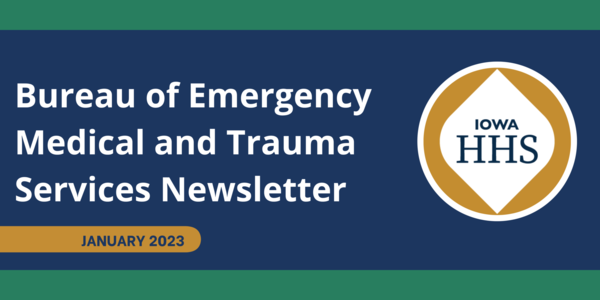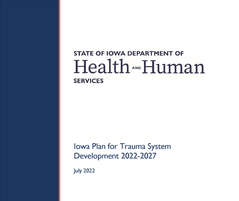
The Bureau of Emergency Medical and Trauma Services at the Iowa Department of Health and Human Services is excited to launch our bureau newsletter! This newsletter is intended to increase the communication EMS and Trauma stakeholders across the state of Iowa receive from the bureau. We want to provide you with timely updates and information on a more consistent basis that not only increases your knowledge of regulatory requirements and resources, but also provides additional transparency to the varied public health work our programs are completing. The newsletter is initially scheduled on a quarterly basis, but as we receive stakeholder feedback and have additional information to share, we may look to an increased frequency. It is important to us that our EMS and trauma stakeholders feel you have the information you need to be successful in your roles and that you have our support as you do your vital work across the state.

As our staff spotlight this quarter, I would like to highlight myself and my relevant work history as a manner of introduction. My name is Margot McComas and I have been serving in the bureau chief role at the Bureau of Emergency Medical and Trauma Services since June of 2022. Prior to taking the role as chief, I served Iowa as the trauma program manager from August 2020. I started my work with the bureau as the trauma system coordinator in February of 2017. Prior to my work with the bureau, I worked as a critical care and trauma nurse in Omaha, NE working exclusively on the night shift. I am a proud Iowan and grew up in the Des Moines area, graduating from Roosevelt High School and the University of Iowa, before attending nursing school at Creighton University. I have Nebraska to thank for giving me the “trauma bug” and I would not trade that incredible introduction to the trauma world for anything. I was also lucky to serve as a critical care bedside nurse in the NTMICU at MercyOne Des Moines from 2017-2020. While I truly enjoyed bedside nursing, I have found my passion lies with systems of care and the continuous quality improvement of those systems. To me, continuous quality improvement means the removal of barriers to achieve successful outcomes in a system.
I look forward to opportunities to work together to solve the complex issues surrounding the EMS and the trauma systems in our state and I truly hope this newsletter provides relevant information that will be beneficial to your individual needs.
|
There are two (2) ways to meet the Iowa EMS provider renewal requirement for continuing education:
1) Current NREMT certification at the level of your individual Iowa certification with an expiration date that is later than March 31, 2023;
OR
2) Completion of the minimum continuing education hours necessary for your individual level of Iowa EMS Provider Certification. Continuing education renewal requirements are presented below.
Please review IAC chapter 641-131 to become familiar with regulations and requirements for the Iowa EMS provider.
The table below illustrates the minimum number of core continuing education hours (CEH) by topic area for each level of emergency medical care provider to renew an Iowa EMS certification.
| Core Topics |
EMR/FR |
EMT/EMT-D |
AEMT |
PM |
| Airways, Respirations, Ventilations |
1 |
1 |
2 |
3 |
| Cardiology |
2 |
6 |
7 |
9 |
| Trauma |
1 |
2 |
3 |
3 |
| Medical |
3 |
6 |
8 |
9 |
| Operations |
1 |
5 |
5 |
6 |
| Totals |
8 |
20 |
25 |
30 |
For questions regarding CEH requirements please contact the Bureau at: (515) 281-0620 or bets@idph.iowa.gov.
Updates to the bureau’s licensing system occurred in early January 2023. As a result, the user experience is slightly different than before. For any AMANDA access questions contact the Helpdesk at: (855) 824-4357 or ADPEREHreg@idph.iowa.gov. For username and password support contact OCIO at (800)-532-1174. For questions regarding license requirements please contact the Bureau at: (515) 281-0620 or bets@idph.iowa.gov.
Follow this link to the updated public portal: AMANDA Public Portal
This year will bring significant changes to some of the elements and formatting of Iowa’s EMS incident registry. Currently Iowa EMS data complies with the National EMS Information Systems (NEMSIS) V3.4 data requirements. Over the course of this year, the Bureau of Emergency Medical and Trauma Services (BEMTS) will begin rolling out the updates necessary for Iowa’s EMS data to be NEMSIS 3.5 compliant. The goal is for all EMS data submitted to Iowa Department of Health and Human Services (Iowa HHS) on or after January 1, 2024 to be NEMSIS 3.5 compliant.
Initially, BEMTS will submit the V3.5 schematron to NEMSIS. A schematron is essentially a coding language used to validate EMS incident data. After NEMSIS’s review and approval, that schematron will be applied to the direct-entry ImageTrend Elite application provided by Iowa HHS. For services that utilize a third-party vendor for their incident registry, the vendor will be able to incorporate the new V3.5 schematron into their registry.
What does this mean for direct-entry users of Elite?
Elite will have both the current V3.4 incident form and a new V3.5 incident form available for services to use during 2023. If a service has their own custom developed V3.4 incident form, they can use the state provided V3.5 form until they’re able to update their respective custom forms to be compliant.
What does this mean for services that utilize a third-party vendor for their incident registry?
While most or all vendors are well aware of this national transition to NEMSIS V3.5, every state’s transition will be unique. Depending on the vendor, it may take a few months to incorporate the Iowa schematron into their respective registry. It is for this reason that once the Iowa schematron has been approved and released by NEMSIS, the services that utilize a third party vendor should contact their vendor for an acknowledgement of Iowa’s schematron availability and expected implementation date.
Additional information regarding this change will be forthcoming in the weeks and months ahead. The bureau understands and appreciates the time and effort required for data capture and submission. We will make every effort to implement this change with as little disruption as possible to everyone involved with EMS data entry.
Thank you,
Terry Smith
Management Analyst, EMS Incident Data Coordinator
Bureau of Emergency Medical and Trauma Services
Trauma System Advisory Council (TSAC) Updates:
The System Development Subcommittee of TSAC has been working diligently this year to develop a DRAFT of the State Trauma Plan for 2022-2027. This written trauma plan will:
- Guide comprehensive system development
- Address system operational requirements
- Allow for local trauma system variations based on assessment results
- Reflect inclusiveness of the operational components as they fall under assessment, policy development, and assurance
- Demonstrate an all-encompassing methodology, ranging from injury prevention activities to prehospital trauma care, acute care facilities, and post-acute care rehabilitation
- Reflect integration with the State Health Plan and with the State's Emergency Response Plan
- Allow for a dynamic process that will evolve with changing injury epidemiology and resource availability - both human and financial
The ultimate evaluation outcome of trauma system implementation is a reduction in morbidity and mortality. Iowa will accomplish this goal by planning and implementing a care improvement process, enhancing system performance, using evidence-based research, developing and implementing targeted injury prevention programs, and revisions to trauma system plans based on system assessments and data-based needs.
The DRAFT version of the State Trauma Plan will be open for feedback through the end of February and can be found here. |
|
 |
Governor Kim Reynolds announced during her Condition of the State address a new $15 million round of funding targeted at growing Registered Apprenticeship (RA) programs across high-demand fields in health care. This year’s programs expands applications to EMT training programs. Applications for this year’s Health Careers Registered Apprenticeship Grant Program will be accepted on IowaGrants.gov through March 9, 2023 at noon. The governor’s press release is linked HERE. Grant documents are linked HERE. A grants webinar will also take place on January 27 at 11:00 AM to highlight the application process and answer questions. Interested participants are encouraged to join. (RSVP Link)
The EMS System Standards subcommittee of EMSAC is preparing to reconvene to review and update the System Standards document based on the ever-changing landscape of EMS in Iowa. We're looking for individuals interested in meeting to provide input from the various EMS models around the state. If you are interested in joining this team and helping to define goals for EMS systems in Iowa, please contact Gary Merrill (gary.merrill@idph.iowa.gov, 515-326-5988).

Legislative Corner
On Tuesday, Jan. 10, 2023 Governor Kim Reynolds signed Executive Order Number 10, putting a moratorium on administrative rulemaking and instituting a comprehensive review of all existing administrative rules. As we move through legislative session, the bureau will work to ensure compliance with this executive order and will communicate with EMS and Trauma stakeholders as additional information is available. For now, any future updates to our administrative rules that govern the EMS and Trauma systems will follow the moratorium and administrative rules process.
|

Did you know?
Beginning July 1, 2022, the Iowa Department of Public Health and the Iowa Department of Human Services aligned to form the Iowa Department of Health and Human Services. What our stakeholders commonly knew our bureau by, the Bureau of Emergency and Trauma Services (BETS), also went through some changes at that time. The Bureau of Emergency and Trauma Services split into two bureaus: the Bureau Emergency Medical and Trauma Services and the Bureau of Preparedness and Response. This split has allowed increased opportunities for EMS, Trauma, and Preparedness and Response activities in our state. We are excited for the opportunity to dedicate additional staff time to EMS and Trauma activities in Iowa and look forward to the complex work facing our programs. During legislative session, stakeholders may see the Iowa Department of Health and Human Services updating the Department administrative rules to remove language that references the old department names and provides various administrative updates. We do not anticipate any other changes to our current administrative rules at this time, but if any updates should occur, we will communicate those as quickly as possible.
|
 The new Iowa Department of Health and Human Services (HHS) website is now live. This is the latest step in Iowa’s HHS alignment initiative that brings content from both agencies, DHS and IDPH, into one unified website.
This interim site is only the first step. During phase two, HHS will create a human-centered website, making the HHS website more user friendly and easier to navigate. This approach begins with designing for the end user and will include added functionality and enhanced accessibility.
Check out the new website here.
To navigate to the Bureau of Emergency Medical and Trauma Services site: Utilize the "Public Health Popular Links" tile. Updates are being made to this new website continuously. Please be patient while we navigate the changes to provide our stakeholders with a more user friendly and easy to navigate experience.
The horrors of war and innovations in EMS and trauma systems of care have been linked throughout history. Up until the Civil War, standard practice was to wait for the battle to end before tending to the injured resulting in potentially avoidable suffering and death. Dr. Jonathan Letterman, known as the ‘Father of Modern Battlefield Medicine’ established the US Ambulance Corps in 1862 with the Army of the Potomac. Ambulances were stationed close to the frontline to respond immediately to reports of wounded soldiers. Soldiers, regardless of which side of the conflict they served, were triaged and transported to appropriate levels of care. This had the result of reduced mortality for the soldiers and also resulted an increase in death and injuries among the Ambulance Corps members. Despite this increased risk, Ambulance Corp members remained committed to saving the lives of their fellow soldiers. The National EMS Memorial Foundation states it perfectly, “[t]o this day, those same unselfish principles drive our country’s dedicated EMS provides to serve ‘so that others might live.’”
From all of us at the Bureau of Emergency Medical and Trauma Services we thank you for your dedication to serving Iowans in both pre-hospital and hospital settings to reduce morbidity and mortality across our state. We look forward to the work ahead.
 |
|
From Letterman’s report on Gettysburg “Over 650 medical officers are reported as present for duty at that battle. These officers were engaged assiduously, day and night, with little rest, until the 6th, and in the Second Corps until July 7, in attendance upon the wounded. The labor performed by these officers was immense. Some of them fainted from exhaustion, induced by over-exertion, and others became ill from the same cause. The skill and devotion shown by the medical officers of this army were worthy of all commendation; they could not be surpassed. Their conduct as officers and as professional men was admirable. Thirteen of them were wounded, one of whom (Asst. Surg. W. S. Moore, Sixty-first Ohio Volunteers, Eleventh Corps) died on July 6 from the effects of his wounds, received on the 3d. The idea, very prevalent, that medical officers are not exposed to fire, is thus shown to be wholly erroneous.” |
To request content to be added and shared in the BEMTS Newsletter, please send correspondence to the email address below.
|